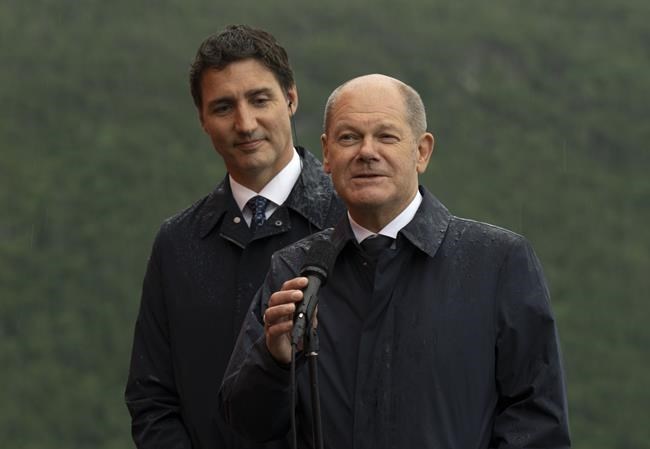ST. JOHN'S, N.L. — The man behind a pitch to build a wind-powered hydrogen facility in western Newfoundland says a recent visit to the region from Canadian and German leaders signalled a big start for Atlantic Canada's hydrogen industry.
Atlantic Canadian seafood mogul John Risley is leading a proposal for a wind-powered hydrogen and ammonia production facility based in Stephenville, N.L. He said Wednesday he lobbied hard to get Prime Minister Justin Trudeau and German Chancellor Olaf Scholz to visit the town earlier this week, where the two countries signed a hydrogen energy deal.
"This is where these energy projects are going to get built; this is where they're going to be managed and operated," Risley said in an interview.
"We hope we left them with a sense of purpose, with the commitment that we've got to rise to the occasion here, and the scale of the opportunity. This isn't just about our project."
Trudeau and Scholz signed a deal to kick-start a transatlantic hydrogen supply chain, with the first deliveries expected in three years. Risley called it a "very large shot in the arm" for the region's nascent hydrogen industry.
Risley is best known as the billionaire co-founder of Clearwater Seafoods. He's now chair of CFFI Ventures, one of four partners in a consortium called World Energy GH2 vying to capitalize on western Newfoundland's steady winds and Germany's hunger to find alternative energy sources to Russian natural gas. The first phase of the consortium's proposal calls for up to 164 onshore wind turbines to power a hydrogen production facility in Stephenville. Long-term plans call for tripling the project's size.
The Newfoundland and Labrador government has asked Risley and his team to provide a full environmental-impact assessment of the project. If approved, the development would be the first of its kind in Canada. The entire project is estimated to cost about US$12 billion, according to a World Energy GH2 news release on Wednesday.
Australia-based Fortescue Future Industries has also submitted plans for a wind-powered hydrogen and ammonia production plant in the area, but the provincial government hasn't yet made those plans public.
"Our biggest hurdle (now) is working with provincial government regulators to help them put in place a regulatory regime that takes account of legitimate concerns around environmental issues, but still allows us to move forward in a manner that provides certainty," Risley said, adding that the consortium is already spending "millions" while its proposal works its way toward government approval.
There was headway made when the four Atlantic premiers agreed Tuesday night to work toward developing uniform regulations and royalties for renewables across the provinces, he said.
"They committed to us that they would work together as a unit of four provinces, so that we don't have one set of regulations in one province that were different from a set of regulations in another," Risley explained. "Honestly, that was profound."
New Brunswick Premier Blaine Higgs said Wednesday the Atlantic premiers signed an agreement to work together to streamline regulations.
"The idea is simply having a harmony of regulation, a harmony of royalties," Higgs told reporters. "We're not in a race here with each other in Atlantic Canada. We're in a race globally to be first place in an industry that is emerging, and in an industry that provides this huge opportunity for us for growth here in Atlantic Canada. We can do it collectively, together."
Meanwhile, Patrick Laracy says the deal signed Tuesday in Stephenville is a real opportunity for his salt reserve in the region. Laracy is the chief executive officer of Atlas Salt Inc., which owns the mineral rights to a subterranean cylinder of salt called the Fischell’s Brook salt dome.
The dome spans an area of about five square kilometres and reaches at least 2.4 kilometres into the earth, and Laracy said its colossal size means it could be used to store industrial quantities of hydrogen gas. Water can be blasted into the mineral to carve out storage chambers, he said.
"It's a very tight rock," Laracy said in an interview Tuesday. "It has a very low permeability, and over time, it has a certain elasticity. So it does not leak."
Storage capabilities will be an important component of any hydrogen project in the area, he said, adding that the Fischell's Brook dome is about 30 kilometres from the port in St. George's, N.L., which is about 25 kilometres south of Stephenville.
Laracy said salt domes aside, the recognition of the wind and hydrogen potential in western Newfoundland means a lot.
"We're going to generate a whole new industry, with all the industrial, employment and other benefits that come with that," he said. "I think it's an important boost to the economy of western Newfoundland."
This report by The Canadian Press was first published Aug. 24, 2022.
Sarah Smellie, The Canadian Press
